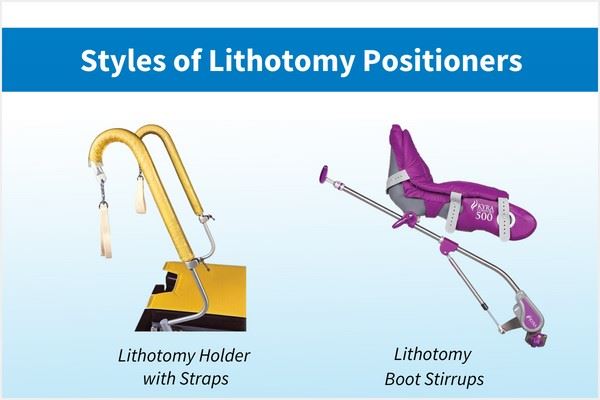-
Home
-
An Introduction to the Lithotomy Position
An Introduction to the Lithotomy Position
April 25, 2023

The lithotomy position, a variant of the supine position, is a common type of patient position that is utilized in various medical examinations and surgical procedures. In this position, the patient is placed on their back with their hips and knees bent at an angle of 90 degrees while their feet are secured in stirrups.
What is the Lithotomy Position Used for?
Use of this position allows healthcare providers with clear access to the genitalia, rectum, perineum, and pelvic organs, making it a commonly used birthing position, as well as for a multitude of different types of procedures, including gynecological, urological, laparoscopic, and proctological exams or surgeries.
Additionally, there are several different modifications of the lithotomy position which are utilized for positional adjustment of the patient on the surgical table, depending on the type of medical procedure. These modifications range from low, standard, hemi, high, and exaggerated. Each of these modifications of the lithotomy position determine how high the lower body is elevated for a given procedure.
How Do You Put a Patient in Lithotomy?
To successfully place a patient in a lithotomy position, a healthcare provider needs to follow a series of specific steps as defined by their facility's protocol and guidelines.
Typical steps may begin with the medical provider positioning the patient lying down on their back on the examination or surgical table. The patient’s hips are often elevated using a leg support or a wedge. The patient's knees are then bent and moved toward the chest. The last step involves the placement of the patient's feet in stirrups, which are then properly adjusted.
Following these steps can help ensure the safety and comfort of the patient during their medical procedure.
When Is a Patient Placed in a Lithotomy Position?
Typically, a patient is placed in a lithotomy position when undergoing medical procedures that require access to regions of the body such as the lower abdomen, pelvis, genitalia, and rectum. Examples of the types of medical procedures that require use of the lithotomy position include childbirth, vaginal examinations, hysterectomies, urethra or colon surgery, and the removal of bladder stones, kidney stones, and gallstones.
To illustrate the importance of the lithotomy position during childbirth for example, when a patient is in the stage of labor, the position helps to open the hip joint and pelvis, making it easier for the baby to move through the birth canal and be delivered.
However, there are risks associated with the lithotomy position, including possible complications such as femoral nerve injury, peroneal nerve injury, and acute compartment syndrome or ACS, especially if the legs are positioned too far apart or raised too high.
Therefore, healthcare providers need to take the patient’s risk factors into consideration prior to a surgical procedure and adjust the positioning accordingly to reduce these risks.
A Look at the Different Styles of Lithotomy Positioners
Two different styles of lithotomy positioners are commonly utilized by medical professionals – these include holders and stirrups. Basic strap-style holders are an economical solution used to secure a patient’s legs in the lithotomy position during a wide range of procedures. An example of this style lithotomy positioner is the AliMed® Lithotomy Holder with Strap, which features a mounting post with an adjustable neck that supports the strap for positioning of the patient.
On the other hand, lithotomy stirrups such as the KYRA® Lithotomy Stirrups include placing and supporting the patient’s legs in padded boots. This full-boot style can help mitigate pressure increases on bony prominences in the knee, calf, shin, or ankle region. It can also protect against potential peroneal nerve damage or unwanted leg rotation.
In addition to these two positioner styles, there are also different types of accessories to aid with lithotomy positioning. One such accessory are KYRA Stirrup Boot Covers, which encapsulates the foot to offer greater protection against cross-contamination for patients that may have foot injuries such as open sores or lesions. The KYRA Urology Attachment Band is another type of accessory used during procedures in lithotomy and includes a reusable and flexible band which supports a drainage bag for catching surgical fluids from the medical procedure.
The lithotomy position is a common examination and surgical position. Understanding its use cases, how to properly put a patient in the position, the various modifications of the position, as well as the different types of lithotomy positioners and their accessories, is important in the healthcare profession so that surgical procedures which require the lithotomy position can be properly carried out.
View more product resources and videos on the Lithotomy Position from AliMed.